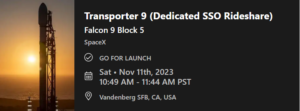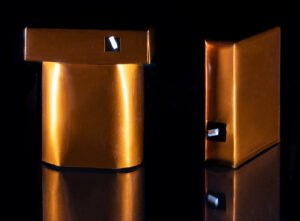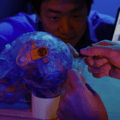A controversial new electric propulsion system, which physicists say defies Newton’s Laws of Motion, was launched into space this weekend aboard a Space X rocket.
Developed by electronics prototyping company IVO Ltd, the Quantum Drive took flight Saturday morning, November 11th, aboard SpaceX’s Transporter 9 mission. This flight included over 80 separate payloads destined for Low Earth Orbit (LEO).


“Launch and deployment were successful!” IVO’s owner and founder, Richard Mansell, told The Debrief in a Sunday email. “We’re getting the satellite’s ‘heartbeat.’ Next step is to establish communication with the satellite.”
In that same email, Mansell said that once communication is established with “Barry-1”, the Rogue Space Systems satellite that is carrying the pair of Quantum Drives (hopefully sometime in the next 24 hours), the satellite will begin going through several steps before the Quantum Drives are actually put to the ultimate test. This includes gathering data in Low Earth Orbit for several weeks to set a baseline for when the drives are engaged.
“Rogue Space Systems and IVO are working closely together to collect a solid baseline of orbital data before firing up the Drives for the first time,” Mansell told The Debrief. “This will help substantiate the thrust results of the Quantum Drives.”
UPDATE: On Monday, November 13th, Rogue Space Systems officially contacted Barry-1.
“Rogue Space Systems has made positive contact with the satellite, and LEOP has begun!” Mansell told The Debrief. “We appreciate them allowing us to be a payload on their first satellite, and so far, it has been great working with them.”
Inventing the Quantum Drive
Earlier this summer, The Debrief spoke with Mansell at length about his company IVO, Ltd, the planned launch of the Quantum Drive, the controversy behind the technology his drives are based on, and what exactly caused him to pursue building something that nearly all mainstream scientists say should not work.
“We began playing around with the idea of ‘what is gravity’ and ‘what is inertia,’” Mansell told The Debrief at the time. “Then I came across the work of Professor Mike McCulloch at Plymouth University.”
On his website, McCulloch notes that Newton’s First Law defines inertia with the observation that “Objects move in straight lines at constant speed unless pushed on.” McCulloch further notes that although Newton defines inertia in these simple terms, the 17th-century genius never quite explains what precisely inertia is.
To explain the true nature of inertia, McCulloch developed his Quantized Inertia (QI) theory, which looks to the strange and mysterious properties of the quantum world for answers. Perhaps unsurprisingly, his efforts to explain inertia have led to wide-ranging criticisms since his proposal seems to defy the laws of motion first set down so many centuries ago, laws that have proven highly reliable for rocket scientists and engineers alike.
Still, Mansell says McCulloch’s work intrigued him. Unlike others who believed the Plymouth University professor might be on to something, he was uniquely positioned to act on it.
In fact, after receiving a patent for a capacitor used in the wireless transmission of power, a primary market for IVO’s commercial endeavor that includes the CBAT wireless transmission system currently undergoing strict FCC safety testing for certification, Mansell realized that his facilities were well equipped to do the initial prototyping of drives built using McCulloch’s theories.
“What if we start off by trying to replicate other people’s work and see if there is any merit (to QI)?” Mansell told The Debrief.


Soon, Mansell and his team were working at their North Dakota Headquarters and a Virginia facility he calls “IVO East,” testing and refining ways to tap into the power of QI. This work was followed by over 100 hours of testing a prototype in a simulated space environment, resulting in their thrust-producing model. The team also recently completed a successful 1,000-hour “stress test,” which the Quantum Drive passed with flying colors.
So, while science said it shouldn’t work, his IVO’s drive seemed to produce the predicted amount of thrust in lab tests. At this point, Mansell said they knew that there was only one thing left to do.
“We got to the point where our third-party inspectors said, ‘At this point, there’s nothing we can do to debug what you’re doing,’” said Mansell. “It’s just got to go to space. It’s really got to go to space.”
Regardless of Results, the Quantum Drive’s ‘Do or Die’ Flight is a First
In another follow-up communication with The Debrief, Mansell noted the significance of the Quantum Drive successfully reaching space, making it the first in its class to move from lab experiments to real-world orbital testing.
“I don’t know of any other purely electric drives ever tested in space,” Mansell told The Debrief, including the controversial EMDrive, which, he noted, relies on a completely different technology but also claims to produce thrust without propellant. “If so, this will be the first time a purely electric, “non-conventional” drive will have ever been tested in space!”
Mansell also believes that whatever happens, his team has shown their customers and colleagues that they can move potentially revolutionary ideas from concept to product in record time.
“Whether or not the Quantum Drives produce the expected thrust, IVO will have shown again that we are capable of not only trying hard experiments, we can do them efficiently and in record time,” said Mansell, noting that his company was ready to go back in June before a glitch with something else on the satellite caused that flight to be canceled.
“In fact,” he added, “we were able to produce the final flight versions of the Quantum Drives in two months!”
How Science and Technology Can Take Big Leaps Forward
Following this past weekend’s successful launch, the tests are only a few weeks away. Then, once the drives are turned on, they will either successfully change the orbit of the Barry-1 satellite, rewriting the physics textbooks, or they will fail, and Sir Isaac Newton will be able to rest easy.
“Our goal is to raise the orbit,” said Mansell. “We would like to do several demonstrations. We’re going to do several orbits of just no thrust whatsoever to get a baseline set of data so we know what the background noise is. And then we’ll turn on the thrusters, the Quantum Drives, and raise the orbit. Then, the goal is to lower the orbit and be able to do this predictably, back and forth, and see if we can change the inclination of the orbit. That would be fantastic.”
Either way, Mansell says he is proud of his team’s efforts to reach this real-world test of their controversial drive. He also notes that in this business, there comes a time when theory must end, and practical testing must take over.
“IVO is always working to push the boundaries in any field it touches, and space is no exception,” he said. “We are not afraid to try difficult experiments–because this is how science and technology can really take big leaps forward. It is imperative not to rely on conjecture or the hypothetical, but real, hard data. This is why we have sent the Quantum Drives to space.”
Christopher Plain is a Science Fiction and Fantasy novelist and Head Science Writer at The Debrief. Follow and connect with him on X, learn about his books at plainfiction.com, or email him directly at christopher@thedebrief.org.

